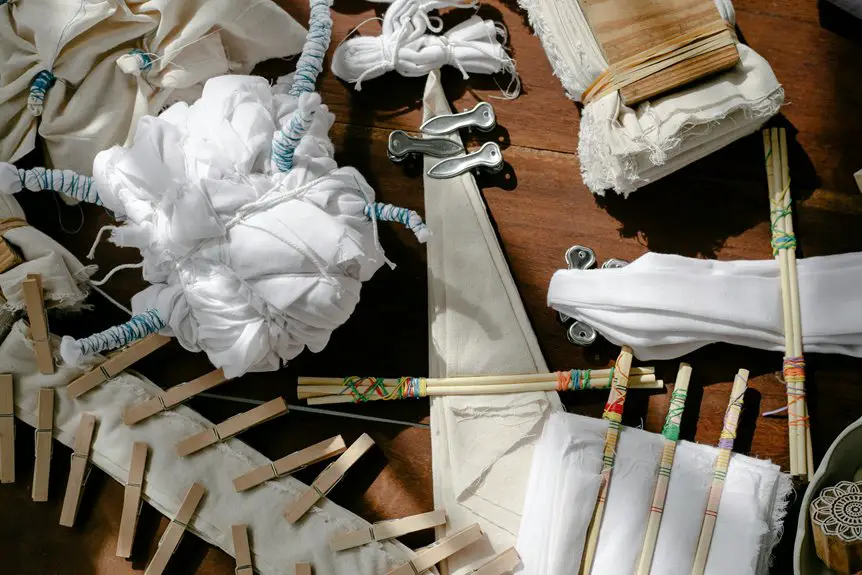You can definitely use batik quilter fabric for clothing since it offers vibrant, unique patterns with a soft yet durable feel. Typically made from cotton or cotton blends, it’s breathable and comfortable to wear. Just keep in mind it needs gentle care, like cold water washing and low-heat ironing, to keep colors bright and fabric lasting. Batik fabric adds a colorful, artistic touch to your wardrobe, and there’s more to discover about styling and maintaining it well.
Table of Contents
Key Takeaways
- Batik quilter fabric, often made from cotton or blends, is soft and breathable, making it suitable for clothing.
- Its unique hand-dyed patterns add artistic character and cultural depth to garments like skirts, shirts, and scarves.
- The fabric offers good durability for everyday wear but requires gentle care to maintain vibrant colors.
- Hand washing in cold water and air drying help preserve the fabric’s integrity and bold designs.
- Styling with neutral or solid pieces balances the bold batik patterns for versatile clothing looks.
Understanding Batik Quilter Fabric
Batik quilter fabric combines traditional dyeing techniques with modern textile design to create vibrant, unique patterns.
When you explore batik fabric, you’ll notice that each piece tells a story through its intricate, hand-dyed motifs. You’ll find that the wax-resist method used in batik produces bold colors and distinctive designs that stand out in any project.
This fabric’s appeal lies in its artistic expression, making it perfect for those who appreciate craftsmanship. You don’t have to be an expert to recognize the beauty and cultural heritage imbued in each yard.
When you choose batik quilter fabric, you’re selecting more than just fabric—you’re embracing a tradition that adds character and depth to your clothing creations.
Fabric Composition and Texture
You’ll find batik quilter fabric made from materials like cotton or cotton blends, giving it a soft yet sturdy feel.
Its unique texture adds character to your clothing while standing up to regular wear.
Understanding the fabric’s durability and care will help you keep your pieces looking great over time.
Common Fabric Materials
Choosing the right fabric can make all the difference when creating clothing with batik quilter material. Common materials include cotton, rayon, and polyester blends.
Cotton is popular because it’s breathable, durable, and holds batik dye well, making it ideal for everyday wear.
Rayon offers a silky feel and good drape, perfect for flowy garments, but it’s less durable than cotton.
Polyester blends add stretch and wrinkle resistance, which can be handy for activewear or easy-care pieces.
When selecting fabric, consider how the material’s qualities match your clothing project’s needs.
Since batik fabrics vary, knowing these common materials helps you predict how the fabric will perform, fit, and feel once sewn into clothing.
Texture and Feel
The texture and feel of fabric play an essential role in how your clothing turns out and how comfortable it feels against your skin.
Batik quilter fabric usually has a smooth, slightly crisp texture due to its 100% cotton composition. You’ll notice it’s lightweight yet has enough body to hold shapes well, making it great for structured garments.
Because it’s cotton, the fabric breathes, so it won’t feel heavy or sticky in warm weather. However, the wax-resist dyeing technique used in batik can create subtle variations in texture, adding a unique tactile quality.
When you wear clothing made from batik quilter fabric, you’re getting a soft, natural feel that’s gentle on your skin while still offering a bit of firmness for shaping.
Durability and Care
Although batik quilter fabric boasts a beautiful appearance and pleasant texture, its durability and care requirements are equally important to take into account.
Because it’s usually made from 100% cotton, you can expect good durability, but it’s not as tough as denim or canvas. To keep your clothing looking great, you’ll want to handle it carefully.
Here are some key points to remember:
- Wash in cold water with mild detergent to prevent fading and fabric wear.
- Avoid high heat when drying; air drying is best to maintain fabric integrity.
- Iron on a low setting, preferably on the reverse side, to protect the vibrant designs.
Durability and Wearability for Clothing
When you wear batik quilter fabric, you’ll notice it stands up well to everyday use without losing its vibrant patterns. The fabric’s tight weave and quality dyes guarantee it resists fading and pilling, making it a durable choice for clothing.
It feels soft and breathable against your skin, so you stay comfortable throughout the day. However, batik fabric can be slightly stiffer than typical apparel fabrics, so it’s best for structured garments rather than flowy pieces.
Keep in mind that while it handles regular wear well, repeated heavy stretching might affect its shape. Overall, batik quilter fabric combines durability with enough comfort for many clothing items, especially those you want to last and keep their eye-catching appeal.
Common Uses of Batik Quilter Fabric
You’ll find batik quilter fabric shines in projects like patchwork quilts, tote bags, and decorative pillows.
It also works great for everyday clothing items such as skirts, shirts, and scarves.
Let’s explore how you can make the most of this versatile fabric in your wardrobe and home.
Popular Batik Quilter Projects
Many quilters turn to batik fabric for its vibrant colors and unique patterns that bring projects to life.
If you’re diving into quilting, batik fabric offers a versatile and striking option that makes your creations stand out.
You’ll find that it’s perfect for a variety of popular projects, including:
- Quilts and quilted wall hangings that showcase bold, artistic designs.
- Table runners and placemats adding a splash of color to your dining area.
- Decorative pillow covers that bring texture and vibrancy to any room.
Using batik fabric in these projects not only highlights its rich hues but also lets you experiment with intricate patterns.
When you pick batik, you’re choosing fabric that complements detailed stitching and enhances the overall visual appeal of your quilting work.
Everyday Batik Fabric Uses
Batik fabric’s vibrant colors and intricate patterns don’t just enhance quilting projects—they also lend themselves beautifully to everyday clothing and accessories. You can use batik fabric to create eye-catching shirts, skirts, or dresses that stand out. Beyond clothing, batik works well for scarves, bags, and even home décor like cushion covers. Its unique design gives any item a personalized, artistic touch.
Here’s a quick look at everyday batik fabric uses:
| Clothing | Accessories | Home Décor |
|---|---|---|
| Shirts & Tops | Scarves | Cushion Covers |
| Skirts & Dresses | Tote Bags | Table Runners |
| Pants & Shorts | Headbands | Wall Hangings |
Using batik fabric adds creativity and color to your daily style effortlessly.
Advantages of Using Batik for Garments
Although it might seem like just another patterned fabric, using batik for garments offers unique benefits that enhance both style and comfort.
When you choose batik fabric, you’re not only selecting vibrant, eye-catching patterns but also enjoying practical advantages that make your clothing stand out.
Here’s why batik works so well for your wardrobe:
- Breathability: The natural cotton fibers keep you cool and comfortable, perfect for warm weather.
- Durability: Batik fabric holds up well over time, resisting wear and tear better than many synthetics.
- Unique Designs: Each batik pattern is distinct, giving your clothes a one-of-a-kind look that’s hard to replicate.
These qualities make batik a smart, stylish choice for your next garment project.
Challenges When Sewing Batik Fabric
While batik fabric offers vibrant patterns and lasting comfort, sewing it comes with its own set of challenges that you’ll want to navigate carefully.
First, batik fabric can be slightly stiffer than other cottons due to the wax-resist dyeing process, which might affect how it moves under your sewing machine needle. You’ll need to adjust your machine’s tension and choose needles suited for medium-weight fabrics.
Also, the fabric’s colors are rich but can sometimes bleed, so pre-washing is essential to avoid unwanted color transfer.
Additionally, matching patterns when cutting can be tricky because of batik’s irregular designs, so plan your layout carefully.
Finally, because batik is less stretchy, you must guarantee your garment’s fit accounts for this to prevent discomfort.
Styling Ideas for Batik Clothing
When you incorporate batik fabric into your wardrobe, you can instantly add a unique, artistic flair to your outfits.
Batik’s vibrant patterns and rich colors let your style stand out effortlessly. To make the most of batik clothing, try these ideas:
- Pair a batik blouse with neutral pants or skirts to balance bold prints.
- Use batik accessories like scarves or headbands to add a pop of color without overwhelming your look.
- Mix batik pieces with denim for a casual yet creative vibe.
Tips for Caring for Batik Fabric Garments
Caring for your batik fabric garments requires a few simple but essential steps to keep their vibrant colors and intricate patterns looking fresh.
First, always wash them by hand in cold water with a mild detergent to prevent fading. Avoid bleach and harsh chemicals that can damage the fabric.
Always hand wash batik in cold water with mild detergent; avoid bleach to protect the fabric’s colors.
When rinsing, use cold water to preserve the dyes. Don’t wring your batik clothing; instead, gently squeeze out excess water and lay it flat to dry in the shade, avoiding direct sunlight which can cause colors to fade.
If you need to iron, use a low heat setting and place a cloth between the iron and the fabric.
Following these tips will help your batik garments stay beautiful and wearable for years.
Frequently Asked Questions
Where Can I Buy Authentic Batik Quilter Fabric?
You can buy authentic batik quilter fabric online from specialty fabric stores like Fabric.com or Etsy. Check local craft shops or markets too—they often stock genuine batik. Don’t forget to verify authenticity before purchasing!
How Is Batik Fabric Traditionally Made?
You create batik fabric by applying wax to cloth, then dyeing it. The wax resists the dye, forming patterns. After dyeing, you remove the wax, revealing intricate designs unique to traditional batik-making.
Can Batik Fabric Be Used for Upholstery?
You might worry batik fabric isn’t durable enough for upholstery, but it actually works well if properly treated. Its vibrant patterns add charm, and with a protective finish, it can handle regular use on furniture surfaces.
Are Batik Fabrics Eco-Friendly?
You’ll find batik fabrics eco-friendly when made using traditional, natural dyes and wax-resist methods. However, some modern processes use chemicals, so you should always check the fabric’s production to guarantee it’s environmentally safe.
What Is the History Behind Batik Fabric Designs?
You’ll find batik fabric designs trace back centuries, originating in Indonesia. They’re traditionally hand-dyed using wax-resist techniques, with patterns symbolizing cultural stories, spirituality, and social status, reflecting rich heritage and artistic expression.
- Does Chiffon Fabric Stink - July 15, 2025
- Does Chiffon Fabric Affect the Economy - July 15, 2025
- Does Cotton Fabric Have a Nap - July 15, 2025







